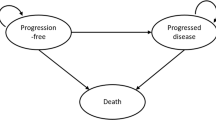Abstract
Docetaxel is an effective therapy for metastatic breast cancer (MBC) and considered a first-line standard of care in many jurisdictions. However, it may be associated with dose-limiting toxicity often requiring dose reductions, delays and in some cases prophylactic hematopoietic growth factors. A nanoparticle albumin-bound (nab) formulation of paclitaxel was developed to overcome the safety drawbacks of solvent-based taxanes and to improve efficacy. A randomized phase II trial comparing nab-paclitaxel 100 or 150 mg/m2 weekly 3 out of 4 weeks and nab-paclitaxel 300 mg/m2 every-3-week (q3w) to docetaxel 100 mg/m2 q3w reported improved progression-free survival (PFS) and reduced toxicity with the former regimens. From resource use captured during the trial, an economic analysis from the perspective of the United Kingdom (UK) National Health Service was conducted. Resource use data contained within the trial database were converted to UK costs. These consisted of costs for chemotherapy, drug delivery, monitoring, supportive care drugs and hospitalization due to toxicity. Univariate and multivariate regression analyses were then conducted to compare the total cost of therapy in patients randomized to each of the four regimens. Growth factor use, hospitalization due to side effects and toxicity-induced protocol discontinuations were higher in the docetaxel group. When all of the cost components were combined for the entire population (N = 300), patients in the nab-paclitaxel 100 mg/m2 weekly and 300 mg/m2 q3w groups had comparable average costs to the docetaxel arm (£15,396 vs. £15,809 vs. £12,923; P = NS). The nab-paclitaxel 150 mg/m2 weekly arm had significantly higher overall costs of £27,222 per patient but had a significant improvement in PFS compared to docetaxel. Relative to docetaxel, the incremental costs per progression-free year gained with nab-paclitaxel 100, 150 mg/m2 weekly and 300 mg/m2 q3w were £5,600, £31,800 and £9,900, respectively. Given its improved safety profile, potentially enhanced efficacy and comparable economic impact, nab-paclitaxel (weekly or q3w) can be considered a reasonable alternative to docetaxel as first-line chemotherapy for MBC.
Similar content being viewed by others
References
Surveillance Epidemiology and End Results (SEER) (2008) National Cancer Institute 2008, Washington, USA. Accessed 2 Nov 2008 from http://seer.cancer.gov/
Chan S, Friedrichs K, Noel D et al (1999) Prospective randomized trial of docetaxel versus doxorubicin in patients with metastatic breast cancer. J Clin Oncol 17:2341–2354
Jones SE, Erban J, Overmoyer B et al (2005) Randomized phase III study of docetaxel compared with paclitaxel in metastatic breast cancer. J Clin Oncol 23:5542–5551. doi:10.1200/JCO.2005.02.027
Bonneterre J, Roche H, Monnier A et al (2002) Docetaxel vs. 5-fluorouracil plus vinorelbine in metastatic breast cancer after anthracycline therapy failure. Br J Cancer 87:1210–1215. doi:10.1038/sj.bjc.6600645
Roché H, Fumoleau P, Spielmann M et al (2006) Sequential adjuvant epirubicin-based and docetaxel chemotherapy for node-positive breast cancer patients: the FNCLCC PACS 01 trial. J Clin Oncol 24(36):5664–5671. doi:10.1200/JCO.2006.07.3916
Bradbury J (2005) Docetaxel downside highlighted. Lancet Oncol 6:447. doi:10.1016/S1470-2045(05)70229-1
Crawford J, Dale DC, Lyman GH (2004) Chemotherapy-induced neutropenia: risks, consequences, and new directions for its management. Cancer 100:228–237. doi:10.1002/cncr.11882
Dranitsaris G, Cottrell, W, Spirovski B, Hopkins S (2009) Economic analysis of albumin bound paclitaxel for the treatment of metastatic breast cancer. J Oncol Pharm Prac 15:67–78
Henderson IC, Bhatia V (2007) nab-Paclitaxel for breast cancer: a new formulation with an improved safety profile and greater efficacy. Expert Rev Anticancer Ther 7:919–943. doi:10.1586/14737140.7.7.919
Gradishar WJ, Tjulandin S, Davidson N et al (2005) Superior efficacy of albumin bound paclitaxel, ABI-007, compared to polyethylated castor oil based paclitaxel in women with metastatic breast cancer: results of a phase III trial. J Clin Oncol 23:1–10. doi:10.1200/JCO.2005.04.937
Gradishar W, Krasnojon D, Cheporov S et al (2007) Randomized comparison of weekly or every-3-week (q3w) nab-paclitaxel compared to q3w docetaxel as first-line therapy in patients (pts) with metastatic breast cancer (MBC). J Clin Oncol 40s (suppl; abstr 1032)
Dranitsaris G (2000) The cost of blood transfusions in cancer patients: a reanalysis of a Canadian economic evaluation. J Oncol Pharm Pract 6:1–6
Varney SJ, Guest JF (2003) The annual cost of blood transfusions in the UK. Transfus Med 13:205–218. doi:10.1046/j.1365-3148.2003.00443.x
George SL (1988) Identification and assessment of prognostic factors. Semin Oncol 15:462–471
Feinstein AR (1996) Multivariable analysis an introduction. New Haven, Yale University Press
Laupacis A, Feeny D, Detsky AS, Tugwell PX (1992) How attractive does a new technology have to be to warrant adoption and utilization? Tentative guidelines for using clinical and economic evaluations. Can Med Assoc J 146:473–481
Dranitsaris G, Lidgren M, Lundkvist J, Coleman RE (2008) nab-Paclitaxel or docetaxel as alternatives to conventional paclitaxel for the treatment of metastatic breast cancer (MBC): a cost utility analysis in five European countries. J Clin Oncol 26(15s) (May 20 suppl; abstr 6571)
Acknowledgments
We are grateful to Abraxis Oncology who provided financial support to conduct this study and for access to the full clinical trial database, which was the starting point for the analysis.
Conflict of interest statement
George Dranitsaris received funding from Abraxis Oncology to perform the analysis. Robert Coleman and William Gradishar received honoraria from Abraxis Oncology for participation in advisory boards. There are no other competing interests to declare. Abraxis Oncology did not contribute in any way to the methodology employed or to the interpretation of the final results. The corresponding author had full access to all the data in the study and had the responsibility for the final decision to submit the paper.
Author information
Authors and Affiliations
Corresponding author
Additional information
G. Dranitsaris: Consultant in Health Economics and Biostatistics.
Rights and permissions
About this article
Cite this article
Dranitsaris, G., Coleman, R. & Gradishar, W. nab-Paclitaxel weekly or every 3 weeks compared to standard docetaxel as first-line therapy in patients with metastatic breast cancer: an economic analysis of a prospective randomized trial. Breast Cancer Res Treat 119, 717–724 (2010). https://doi.org/10.1007/s10549-009-0424-z
Received:
Accepted:
Published:
Issue Date:
DOI: https://doi.org/10.1007/s10549-009-0424-z




